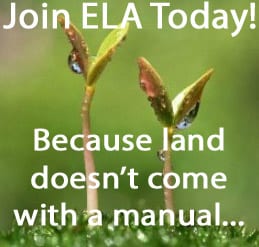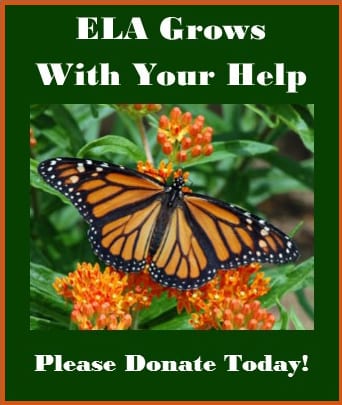Native Plants
By definition and for argument sake, let’s define Native Plants as uncultivated flora indigenous to geographic regions, which have adapted over time to various environmental and social influences such as soil types and hydrology, micro-climates and human influence. Because native species evolve for survival, they tend to be more naturally adapted to local growing conditions and often require less inputs for successful establishment and can reduce maintenance. Native plants play a very important role in our ecosystems. As ecologists, wildlife biologists and entomologist have shown, native plant species are more favorable for supporting pollinators and local wildlife, including insects such as bees, butterflies, amphibians, reptiles and mammals.
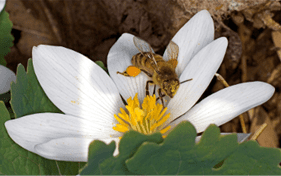
A small andrenid bee packs the pollen baskets
on her hind legs with pollen from bloodroot
(Sanguinaria canadensis).
As stewards of this planet, we have many beautiful options for planting native ground covers, perennials, shrubs, vines and trees. ELA archived newsletter articles offer additional information and are easily accessible to share more of the benefits of incorporating native plant species into our landscapes.
Here are a few samples articles which highlight the use of native plants:
The Lives of Spring Wildflowers by Carol Gracie looks at spring ephemerals and discusses their importance to local pollinators.
And Dan Jaffe takes a broader look at native plants that support wildlife in his article Where the Wild Things Are: How to Support Wildlife in the Modern Gardening World.
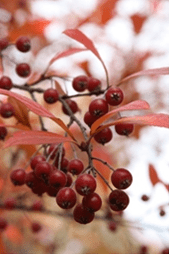
The fruit of chokecherry (Aronia spp.) is an important food source for a number of wildlife species.
Native plants are a food sources for people, pollinators and wildlife alike. For more information on creating your very own food source with native plants, check out Ellen Sousa and Russ Cohen’s exploration of the topic by offering up some interesting examples in Edible and Landscape Worthy Native Plants of New England.
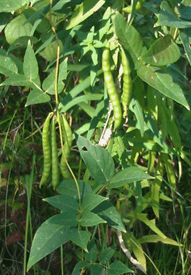
Groundnut (Apios Americana) produces beans and peanut-like tubers that are edible and were a staple for Native Americans and early colonists.
Geopolitical and ecological boundaries greatly influence native species. The greater the geographic range a native plant inhabits, the greater the chance that particular species can experience genetic diversity. These native plant species are known as Ecotypes. The importance of ecotypes, can be viewed as a way of defining which native plant species has experienced greater adaptation to local growing and site conditions. Ecotypes are often ideal choices for conserving natural resources.
One example of native plants used in landscapes striving to conserve water is explored by by Bernadette Balics in California Native Plants Gain Popularity among Suburbanites.
For a broader look at the sustainability aspect of native plants, refer to Scott LaFleur’s and Tom Smarr’s article Going Native: the Sustainable Choice or E. Roxanne Gawthrop’s and Sabrina Cutting’s article Find the Right Native Plant for Site Conditions.

Redbud (Cercis occidentals), a spring bloomer and water-wise California native plant, entices a Pipevine Swallowtail butterfly.
Additional articles and webinars **on the webinar page we need a list of titles available to members** offer more information about native plants. (AGREED here is a link I thought addressed many of the topics in this landing page)
Other Resources
Invasive Plants
Exotic plants are often referred to as non-native, introduced or even alien plant species than have been introduced into our landscapes and ecosystems.
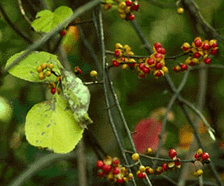
The fruit of Oriental Bittersweet Celastrus orbiculatus was prized for floral arrangements, but the highly-adaptable vine takes advantage of areas of disturbed soil and ou-tcompetes other plants.
Exotic plants historically have been transported across geographic boundaries via humans, climatic events, migratory birds, fauna, etc. In the past, governments, scientist, nurserymen and others have introduced exotic plant with minimal or no negative effects. However, this is not always the case and some exotic plants are labeled as Invasive Plants. Arguments can made that invasive plants disrupt ecosystems by overtaking native flora, potentially limiting or eliminating food sources for pollinators and fauna, changing the flora gene pool through hybridization and altering soil chemistry making it more difficult for native plant species to flourish. Sometimes a native plant can become invasive in particular conditions, but a knowledgeable Eco-Pro can advise you on where to locate and select plants so that both the plant, your landscape and the ecosystem thrive.
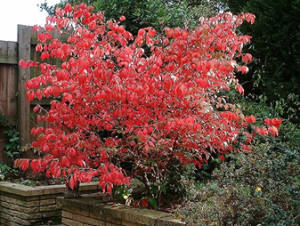
Burning Bush (Euonymus alatus corymbosum) was a landscaping staple for many years, but the plant escaped cultivation and now encroaches on woodlands in eastern North America. Photo by Chris Barton.
An educated ecological landscape professional considers a plant’s ecological function, its role in both the micro and macro landscape. For example, a plant may be able to provide food or habitat for wildlife, help regulate or control the flow of water through a landscape, and contribute to overall soil health by supporting beneficial microorganisms. Not all plants are created equal and to maximize the benefits of any plant, one should make careful considerations when choosing and siting plants in the landscape.
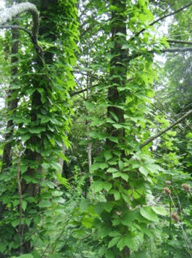
Although non-native plants are a greater threat, even native species like Virginia Creeper can be considered a nuisance or even invasive under the wrong conditions.
It can be a bit tricky determining what constitutes a “native plant” in a particular region, but there are a number of online resources to identify local plants and to locate sources for them:
Lady Bird Johnson Wildflower Center has a native plant database for North American plants: The Biota of North America Program
New England Wildflower Society offers a tool for identifying common native and naturalized New England plants.
Ecological control of invasive plants (control with non-toxic or least toxic options) is evolving. Many ELA articles discuss Invasive Species and offer methods and tools for controlling invasive plants. A valuable resource for identifying non-native or invasive plants is the Natural Resources Conservation Service PLANTS database.
Substituting a native species for a non-native plant makes good ecological sense. There are many hardy and beautiful alternatives.
ELA Membership
One of the benefits of an ELA Membership is the access to informative webinars on a variety of topics concerning ecological landscaping. Below is a sample of a recent webinar on the topic of invasive plants. To become a member, visit the membership page.
Our Mission
The Ecological Landscape Alliance (ELA) was founded in 1991. We advocate for environmentally responsible stewardship of land and natural resources in landscaping and horticultural practices of both professionals and the public. Through education, collaboration, and networking, ELA promotes the design, installation, and maintenance of landscapes that are guided by a knowledge of and respect for natural ecosystems. (read more)

